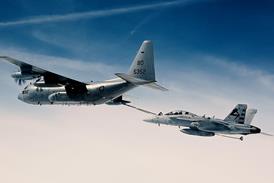Paul Lewis/SINGAPORE
A China Airlines (CAL) Airbus Industrie A300-600R crashed next to Taipei's international airport in Taiwan on 16 February as the crew was apparently initiating a go-around. There are indications that the aircraft may have stalled in the attempt.
The seven year old aircraft, aiming for runway 05L, crashed just beyond the airport's western perimeter fence, killing all 196 passengers and crew and six residents on the ground. The impact point was 2,400-2,700m (8-9,000ft) from the threshold of the adjacent 3,660m-long runway. After impact, the aircraft crossed a road, went through a wall and hit housing.
Wreckage was spread over an area some 400m in length along a projected track of 017-020¹, some 30¹ left of the 053¹ runway centreline alignment. Visibility was reported as about 1,000m and, according to the Taiwan Civil Aviation Authority, the aircraft was making a Category 1 instrument landing system (ILS) approach.
Preliminary examination of the crash site shows a V-shape gouge at the start of the debris trail, believed to have been made by the A300's tailplane and indicating that the aircraft had a nose-up pitch attitude, thought possibly to be consistent with a stall during a go-around attempt. The position of gear debris suggests that the undercarriage was up, and slats and flaps were not set fully down, although the crew had just acknowledged final clearance to land. The Pratt & Whitney PW4158 engines are reported to have disintegrated, indicating they were at high thrust.
In a transcript of messages between Taipei tower and flight CAL676, landing clearance is given at 20:04 local time, with wind velocity 360¹/3kt. CAL676 acknowledges: "Roger, clear to land", at which point an audio alert, believed to indicate autopilot disconnection, sounds. Moments later the aircraft is heard to make the unfinished call "Tower, Dynasty [CAL call sign]-" The tower controller responds: "CAL676, confirm go around?" Then the crash alarm is activated.
The missed approach procedure for 05L is to climb on runway heading to 800ft and turn left to intercept the airport VOR [VHF omni-directional] navigation beacon's 294¹ radial, ensuring clearance from high ground to the east and south.
Immediately after the accident, the Taiwan CAA ordered precautionary grounding for checks of CAL's nine A300-600s. With the checks almost complete, CAL has not declared any significant technical problems. The CAA, however, has also ordered the airline to put 140 of its A300 pilots through a simulator re-evaluation course under its supervision, which is expected to take about a week. The A300's flight data recorder and cockpit voice recorder are being sent to the Australian Bureau of Air Safety Investigation for analysis.
This is the second A300-600R to be involved in a fatal accident since the type entered service in 1984. The other, in 1994, at Nagoya Airport, Japan, also involved a CAL aircraft.
Source: Flight International























